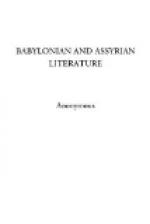ANNALS OF ASSUR-NASIR-PAL (SOMETIMES CALLED SARDANAPALUS)
TRANSLATED, WITH NOTES, BY REV. J.M. RODWELL, M.A.
Concerning Assur-nasir-habal or Assur-nasir-pal (i.e., “Assur preserves the son”) we possess fuller historical records than of any other of the Assyrian monarchs, and among these the following inscription is the most important. From it, and from the inscription upon his statue discovered by Mr. Layard [Footnote: Now in the British Museum.] in the ruins of one of the Nimroud temples, we learn that he was the son of Tuklat-Adar or Tuklat-Ninip, that he reigned over a territory extending from the “Tigris to the Lebanon, and that he brought the great sea and all countries from the sunrise to the sunset under his sway.” These inscriptions are published in the “Cuneiform Inscriptions of Western Asia,” Vol. I, plates 17 to 27, and were partially translated by Professor Oppert, “Histoire des Empires de Chaldee et d’Assyrie,,” page 73 and following “Extrait des Annales de philosophie chretienne” tom. IX, 1865.
There is considerable difficulty and a consequent divergence of opinion as to the precise date when Assur-nasir-pal ascended the throne. But he most probably reigned from 883 to 858 B.C.
It need scarcely be remarked that Assur-nasir-pal is a different person from the well-known Sardanapalus of classic writers, or Assur-bani-pal, the son of Esar-haddon, who reigned from about B.C. 668 to 625.
It will be seen from the inscription that the campaigns of Assur-nasir-pal took place in the mountains of Armenia, in Commagene and the provinces of the Pontus, inhabited by the Moschi [Footnote: The Mesek of Psalm cxx. 5.] and other tribes. He probably advanced into Media and a portion of western Persia. The countries on the banks of the Euphrates submitted to his arms, and in one of his expeditions he vanquished Nabu-bal-iddin, King of Babylon. Westward, he reduced the southern part of Syria, and advanced to the mountain chains of the Amanus and Lebanon, but though he penetrated as far as to Tyre and Sidon and exacted tribute from both as well as from Byblus and Aradus, he did not subdue Phoenicia. The kingdoms of Israel and Judah, under the sway of Ahab and Jehosaphat, were no doubt too powerful, as is evinced by the armies which they must have maintained for their struggle with the Syrians, [Footnote: See 2 Chron. xvii. and following chapters.] for Assur-nasir-pal to have ventured upon attacking them. This feat was reserved for his successors on the throne of Assyria.
The inscription was found in the ruins of the Temple at the foot of the Pyramid at Nimroud (Calach).




